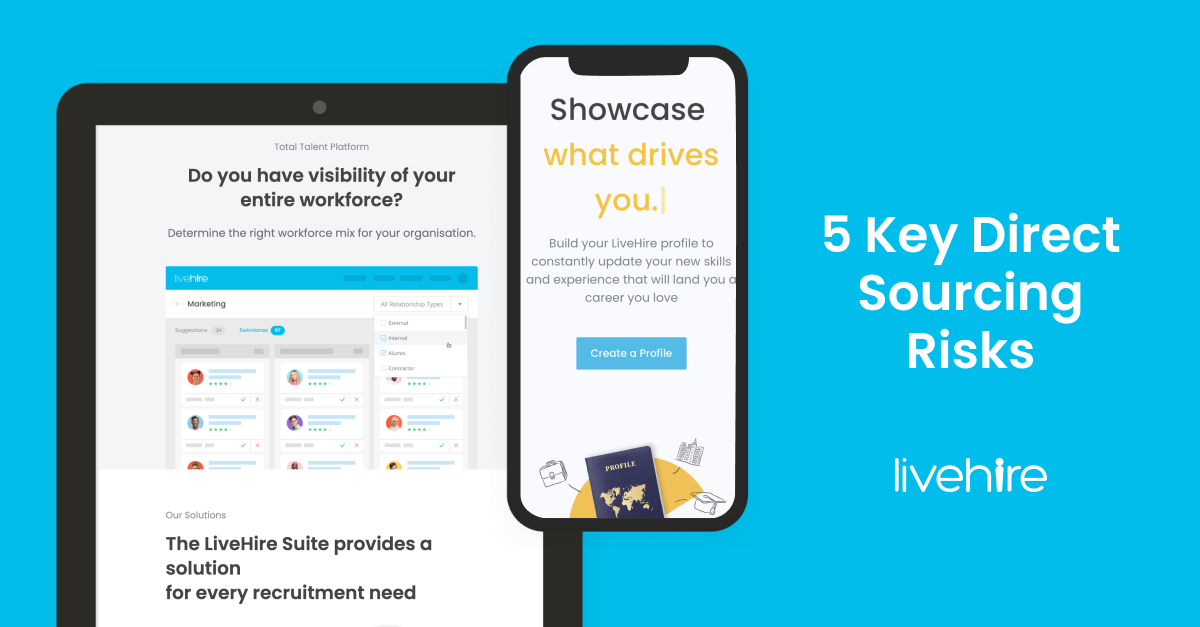
As we emerge from worldwide economic disruption, shifts in organizational structures and processes are driving a major workforce transformation. To this end, 77% of executives worldwide believe the freelance and gig workforce will markedly supersede full-time employees within the next 5 years. Thus, business leaders across industries are looking for new, innovative ways to drive contingent hiring efficiencies. In answer to this challenge, The Direct Sourcing Toolkit by Ardent Partners has found that 70% of businesses are making Direct Sourcing and talent pool curation a top priority.
What is Direct Sourcing?
As it relates to this article, Direct Sourcing is the process wherein companies leverage their own brand and network to attract and engage contingent workers. That is, they create a Talent Cloud of candidates for temporary employment roles at their company.
If you’re still seeking clarity on Direct Sourcing, we have written a guide to direct sourcing, weighed up the pros and cons of investing in Direct Sourcing and debunked the most common myths related to Direct Sourcing.
Many agree, Direct Sourcing offers a promising solution for driving contingent workforce management efficiencies. Yet, only 16% of contingent program leaders surveyed by Staffing Industry Analysts (SIA) strongly agree Direct Sourcing is being effectively implemented. Among the most salient challenges facing procurement and HR leaders implementing Direct Sourcing programs, is risk mitigation. Given Direct Sourcing is in the early adoption phase, there is no hard and fast risk mitigation road map. Before implementing a Direct Sourcing program from scratch, it is vital that organizations are armed with the necessary knowledge for navigating the major risks and compliance issues.
This article will explore 5 key risks associated with implementing a Direct Sourcing program.
5 Key Risks of Direct Sourcing
Here at LiveHire there are 5 key risks we discuss with companies in their review phase prior to implementing our Managed Direct Sourcing (MDS) solution. They are:
- Candidate experience and brand impact
- Co-employment and independent contractor misclassification
- Data privacy
- Discrimination
- Change management and communication
1. Candidate Experience and Brand Impact
Most large companies invest millions of dollars in customer experience and branding each year – and the impact of that investment can be enormous. The value of Apple’s brand, for example, is estimated at $263 billion and the company is well-known for its Genius Bar and outstanding customer service.
With all the emphasis companies place on branding and customer experience, it’s often surprising that:
- So many companies still don’t have a Branded Talent Cloud dedicated to their contingent workforce. Your brand is a valuable asset you could be using to attract the best talent.
- Many companies don’t give candidates the same white glove treatment they provide to their customers.
Your candidates are also consumers. Let’s reflect on that for a moment. Candidates, i.e. the people who apply for a job and often get an automatic, computer-generated email, are the people who buy your company’s products or use its services. The direct link between candidate experience and revenue is a powerful insight, and one that immediately makes CEO’s and Heads of Marketing take note. Research by Virgin Media in the UK found that rejected candidates switched their subscriptions to competitors, costing them $5 million in revenue per year. As a result Virgin Media overhauled the recruiting process, placing candidate experience firmly at its center.
Treating candidates as customers helps to ensure a positive candidate experience. Your Direct Sourcing strategy needs to be candidate-centric and understanding of what candidates want. A study by PWC in 2019 said that nearly half (49%) of job seekers say they’ve turned down an offer because of a bad candidate experience. Further to this, PWC said that today’s candidates expect a technology-led, human centred hiring process coupled with instant communication.
You need to ensure your Direct Sourcing solution incorporates cutting-edge, instant technology, such as LiveHire’s 2-way text messaging. 2-way text messaging is the perfect way to communicate with candidates immediately and en masse, while still allowing full customization and personalization to ensure communication is humanized.
And instant communication is a real competitive advantage, especially in a candidate short market. A recent study showed that 42% of recruiters said that slow response times to calls and emails was a key barrier to hiring. But this barrier is no more. The results of text communications are impressive – LiveHire has a 17 minute median response time to text messages between recruiters and candidates and a 96% positive candidate satisfaction rating.
2. Co-Employment Risk and Direct Sourcing: is it even a thing?
It’s not uncommon for contingent workforce leaders to raise questions about co-employment risk. Here at LiveHire, we partner with leading US staffing firms to deliver Managed Direct Sourcing solutions. We feel one such staffing firm, Procom, defines co-employment very succinctly: “Co-employment risk is the term used to describe situations where two or more organizations exert some level of control over a worker, and are therefore considered to have employer obligations toward the employee. Co-employment risk can often exist when organizations use staff that are provided by third parties”.
With contingent workers representing 46.5% of the US workforce according to the latest data from Ardent Partners, co-employment is a frequent topic of discussion. It can occur when a staffing supplier engages a contingent worker on behalf of their client (the enterprise). Therefore, the staffing company has primary responsibilities for recruitment and payroll, whereas the enterprise handles the work agreement. And with these shared obligations, comes the risk of co-employment.
What’s the key legislation in the United States?
Of note, co-employment has another name, ‘joint employment’. While it can be difficult to find a single definition of co-employment/joint employment to reference, there are various employment laws where co-employment can occur, as it relates to that specific piece of legislation.
Why is co-employment risk important to understand?
Risks involved in co-employment include:
- Not classifying independent contractors correctly
- Treating independent contractors as employees
- Lack of understanding that an independent contractor is in their own right a business entity
- Not partnering with a supplier who understands co-employment risk
Importantly, co-employment is not a violation of employment law in the US. As stated above, it is a central component of staffing supplier engagements, with a clear separation of obligations to the contractor. As the Staffing Industry Analysts put it “Many experts view co-employment risk as a fact of life, particularly in dealing with contingent workers and staffing agencies.”
The key to demystifying this: at what moment in time is the worker contracted?
On the topic of myths, one of the most common circling the contingent workforce industry currently, is that implementing a Direct Sourcing strategy plays a part in co-employment risk. In reality, it has no impact. Direct Sourcing is simply the process of leveraging your employer brand to attract leading talent. It is a strategy to attract talent, but has no bearing on the ongoing employment arrangement.
When you source talent there are not yet any obligations to the contingent worker. Once a contingent worker accepts a role, then it’s important to safeguard against any practices that could expose the organization to co-employment risk.
Independent contractor misclassification
Now we are clear that co-employment is not impacted by Direct Sourcing, why is the question of co-employment risk still on the minds of so many contingent workforce leaders?
A critical subcomponent of co-employment is classifying your independent contractor correctly. While we touched on this briefly in the section above, this warrants more coverage due to the impact it can have when not correctly understood and addressed.
In line with IRS 1099 guidelines, a worker is classified as an independent contractor if the payment provider is responsible for directing only the result of their work. That is, not what or how the work will be done. However, a current trend in the US is the adoption of stricter state-based tests for the classification of independent contractors. Driven by this trend, the 2020- 21 CXC Contingent Workforce Global Trends report has found the US is currently rated medium to high risk for contingent worker misclassification claims. To this end, it is critical that businesses are clear on their state-based regulations and the extent of control versus independence in the worker- employer dynamic.
As it relates to Direct Sourcing, it is important to be aware that while on the one hand, a Direct Sourcing program should enable speedier access to well-fitted contingent workers, management and messaging to contingent workers must be in accordance with state independent contractor regulations.
The image below is a heat map depicting where organizations worldwide are facing modern workforce risk, in particular contingent workforce misclassification claims risk. As mentioned above, the US is currently listed as medium – high risk.
Image source: https://www.cxcglobal.com/wp-content/uploads/2020/11/2020-2021_CXC_CW_Global_Trends_Report-2.pdf
3. Data Privacy for Direct Sourcing
In 2016, the EU adopted the General Data Protection Regulation (GDPR) – largely considered the gold standard of data protection policies. As countries outside of Europe begin enacting similar legislation, the world is taking gradual steps toward a cohesive approach to data privacy.
In the US it is not yet as clear cut as in Europe, but individual states continue to pass new laws in the absence of federal legislation. The most notable of these is the California Consumer Privacy Act (CCPA), which states that companies need to provide more information to consumers about what’s being done with their data and give them more control over how or if this data is shared. This legislation went into effect in 2020, with some of the key requirements including:
- Right to disclosure
- Right to access
- Right to contact information
- Right to be forgotten
- Opt-out of data sales and marketing
- Right to fair treatment
- Periodic privacy policy updates
While there are many similarities between CCPA and GDPR, it’s best to consult an expert on some of the nuances between these two data privacy frameworks.
Who is responsible for data privacy risks when leveraging a Direct Sourcing solution?
This depends on the structure of the Direct Sourcing program you set up, the partners you choose to work with, and clarifying who ‘owns’ the data. For example, a key part of GDPR is understanding the difference between data processors and data controllers.
The data controller determines the purposes for which and the means by which personal data is processed. The data processor processes personal data only on behalf of the data controller. The data processor is usually a third party external to the company.
Depending on the role each partner plays in delivering a Managed Direct Sourcing solution and the nuances of data ownership, these roles may need to be clearly defined. In most cases, the role of a technology provider is merely to process data on behalf of the enterprise, who owns and controls the data.
When assessing potential technology partners, we recommend reviewing their privacy policy and awareness of recent legislation to ensure you understand what information they collect, how it will be used and how they protect it.
4. Discrimination – reducing bias in your Direct Sourcing program
The challenge of reducing bias in permanent hiring has been around since hiring began. Undoubtedly, your internal talent acquisition team will be working to remove bias from their processes wherever possible. This also must be considered as an identified risk when embarking upon a Direct Sourcing program. There is already a large body of work and research out there that shows the recruitment experience is prone to bias, so how do you mitigate this risk for your Direct Sourcing program?
Bias can creep in from existing employees who have pre-designed ideas on what would be a ‘fit’ for based on the six points identified in the image directly above, and what they think is needed to succeed in the role. But with this bias also comes subjectivity.
By implementing a Managed Direct Sourcing strategy and having a trusted staffing partner run your talent curation, you immediately mitigate the risk of bias as the staffing partner is not privy to the environment that causes the bias.
Second to this, you can include in the staffing partner’s KPIs diversity hiring targets, by holding them accountable to think about diversity early in the project you will improve the performance of the contingent recruitment process.
How can you improve diversity outcomes?
LiveHire research shows that diverse candidates need to be reached at the very beginning of the talent pipeline to achieve better diversity within an organization. To attract diverse talent, you need to rethink traditional hiring practices in order to eliminate diversity barriers. For example, studies indicate that men will apply for a role if they meet at least 60% of the desired job qualifications – but women will only apply if they meet 100% of them.
By building a branded Talent Cloud for your contingent workforce, candidates of all backgrounds can express interest in your company, rather than responding to strict, criteria-focused job ads. Most hiring platforms are designed to filter and reject candidates, rather than inviting them to express interest in the employer brand. LiveHire offers a more inclusive platform that puts candidate experience front and center.
Moreover, LiveHire can help reduce the likelihood of bias in the hiring process through highly configurable notifications that remind system users to consider diversity, equity and inclusion goals at each step of the process.
5. Change Management and Communication
Direct Sourcing brings many benefits with it such as increased quality of hire, improved time to hire and reduced cost of hire. That said, driving significant change in a large company can be difficult and organizational inertia can limit the potential benefits of your Direct Sourcing strategy.
The key to winning hearts and minds is to focus on articulating the reasons for change in a simple, compelling way that solves a business problem. Rather than starting with the solution – start with your problem statement. Identify early on what pain points you want to resolve and how these impact other stakeholders. Begin by asking yourself who will benefit from the change you are proposing. You may identify more supporters for your Direct Sourcing transformation beyond your immediate team.
Some organizations begin their transformation journey by mapping out the entire contingent hiring process to ensure alignment to the overall business needs. Having a visual picture of their processes and analyzing challenges where they want to improve, allows them to form a clear problem statement that they can keep referring back to.
Another approach taken by some clients is to invite their business stakeholders to validate the pain points they have identified. This helps them to form the basis of the ‘case for change’ and ensures a clear objective about their desired future state.
Business readiness management
Take steps to ensure a smooth transition and maximize the impact of your Direct Sourcing program by following these change management best practices.
Change Impact Analysis: Change impact analysis is an assessment of what will change as a result of a project implementation and the subsequent impacts to people, processes, technology and the broader organization. Most of these changes should be surfaced in consultation with your Managed Direct Sourcing partners as you map out your future process, define the roles and responsibilities of each stakeholder, and identify potential efficiency opportunities.
Stakeholder Management: Stakeholder management and communications essentially acts as the ‘voice’ of the project. To do this effectively, segment stakeholders into logical groupings and deliver the right message at the right time to the right people, taking them on the journey from awareness to understanding and adoption.
Launch and Post Go-Live Support: The aim of launch and post go-live support is to ensure the business is ready, supported and smoothly transitioning to the new ways of working. The focus is on activities that directly support the shift to your new Managed Direct Sourcing solution, such as training and ongoing support.
In Conclusion
Implementing a Direct Sourcing program entails a number of risks that, when considered carefully from the outset, can be well mitigated. Further, with the right partner ecosystem, you can collaborate with existing industry specialists who already know how to manage all of these risks and can help you maximize the benefits of your Direct Sourcing program.
Now that you have evaluated the potential risks, are you ready for the next step in your Direct Sourcing journey?






